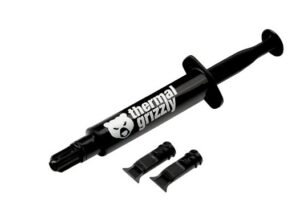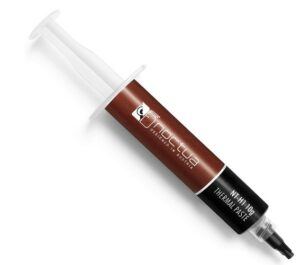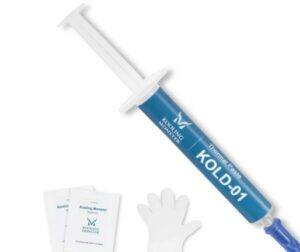Often, manufacturers and computer repairers do not have thermal paste available. It is crucial because it helps calm the CPU temperature, reducing the thermal resistance between the microprocessor and the heat sink.
This article look at how to effectively replace the thermal paste with different, inexpensive materials like toothpaste.
What is thermal paste all About?
Thermal paste is a dense composite material that improves the thermal contact between electronic components and a heat sink.
It is essential to use it on CPUs as they are very inefficient components and waste a lot of energy in unused heat.
What is a thermal paste made of?
Thermal paste is made with zinc oxide and silicone. It has a high thermal conductivity. There are also liquid metal products that have high thermal conductivity.
Can toothpaste replace thermal paste?
Toothpaste is also a great alternative to the thermal paste. Its structure decomposes after a few days, especially if the operating temperature is high.
It is also conceivable to add a little Vaseline to these proportions:
- Toothpaste: 80%;
- Vaseline: 20%.
Vaseline grease prevents toothpaste from drying out. It would help if you separated the mixture for at least five (5) minutes .
Fill a syringe with the resulting mix, and press evenly to apply a thin layer on the CPU (or on the heat sink towards the contact).
It will work for 3-4 months in principle. However, it is better to control the situation and change it every 15-30 days.
When it is removed, tiny spots may appear on the metal. However, with a bit of 90% alcohol and cotton, you can remove these stains.
You can then reapply the paste. Not all toothpaste is suitable for this purpose. Some types of toothpaste have higher thermal conductivity than others.
This category of product is too wide to generalize. Therefore, you should apply it on a case-by-case basis.
Using toothpaste as an alternative is a solution that fills microholes with air, so it is unsuitable. The main features of toothpaste can be as follows:
- Adhesive strength on metal surfaces;
- Consistency at different temperatures;
- Proper operating time before it expires;
- Ability to fill microsphere flaws;
Electrical insulation
It is possible to disperse the new paste using the old credit card as a brush to distribute the mixture evenly.
Aluminum powder
Another solution to use as a thermal paste is to mix an excellent smooth aluminum powder with Vaseline oil.
You should blend the mixture for at least 10 minutes to avoid the presence of tiny air bubbles. You can make the powder home by rubbing a piece of aluminum or purchase it from a specialty store.
Vaseline oil has a high boiling point (over 280 ° C) and is relatively inert. When immersed in oil, aluminum does not oxidize.
Diaper rash cream
This type of cream is high in zinc oxide, a significant component of commercial thermal paste. You can put a thin layer on the heat sink, which works very well for 5-6 months without any hassle.
Before smearing the new mixture, carefully clean the surface of the CPU with alcohol.
Here is some premium quality thermal past that you need:
| IMAGE & DISC | PRICE LINK |



Other solutions
The test solutions are endless, and chemistry enthusiasts can find a system to make an emergency thermal paste. Here are some other possible ideas, maybe on an older CPU.
Although thermally and electrically correct, some substances can withstand high temperatures for a short time, so their degradation occurs moderately quickly. Here are some products that can be accessed, individually or through a combination:
- American Cheese
- Yellow cheese
- Hair wax;
- Moisturizing cream;
- Butter;
- banana;
- Card
- Adhesive for dental prostheses
- Spread cheese
Ketchup and mustard have an intriguing thermal coefficient as well. Unfortunately, both products have a 24-48 hour shelf life.
Butter and moisturizers are also effective short-term solutions, but they melt after a few minutes. Potential oil spills on circuits can also threaten motherboards and nearby electronic circuits.
Pros
- You can also utilize toothpaste in place of thermal paste. Its structure degrades after a few days, mainly if used.
- Yes, why not? You can also slim down on some slices of bread as an alternative to the heat sink. We use thermal paste, which prevents the CPU from frying due to the heat generated. The CPU is one of a computer’s most expensive parts; don’t mess with it unless you have a lot of money waiting to be spent.
- Temperatures are high.
- Available easy at home
- Create Cooling Effect
Cons
- Can you drink petrol instead of water? Thermal compounds have different properties to absorb heat. Toothpaste is made for teeth, so you should not do that. If you want to try, do it at your own risk.
- Just because we use Colgate for the cooling effect when the skin burns don’t mean it can help control the temperature of the CPU chip.
- Want to burn a CPU for a few hundred dollars to save a few dollars for thermal paste? “Very smart” if you want it. The best solution is not to use anything; it is better than toothpaste.
- Tattoo paste means brushing your teeth. Thermal paste (or “heat sink compound” commonly known) is a unique formulation with specific metal compounds intended to transfer heat from electronic components to the heat sink. Toothpaste does not have any of these properties.
https://youtube.com/shorts/kZt25S4K-oQ?feature=share
Final Thought
Numerous thermal paste substitutes are available on the Internet. However, using homemade methods will void the CPU warranty.
There’s no reason to burn a microprocessor because a commercial thermal paste tube costs less than $10, enough for many applications.
However, the key to success is constantly to cool the system properly. If not, a better and more efficient heat sink is required. Component ventilation should also be guaranteed and ensured by an adjustable constant airflow.

